Accessible version available at unr.edu/wolf-pack-rising.

NEVADA SYSTEM OF HIGHER EDUCATION BOARD OF REGENTS
Cathy McAdoo, Chair
Patrick R. Carter, PhD, Vice Chair
Joseph C. Arrascada
Patrick J. Boylan
Byron Brooks
Amy J. Carvalho
Carol Del Carlo
Mark W. Doubrava, M.D.
Jason Geddes, PhD
Donald Sylvantee McMichael Sr.
John T. Moran
Laura E. Perkins
Lois Tarkanian
Keri D. Nikolajewski, Interim Chief of Staff to the Board
LAND ACKNOWLEDGEMENT
We acknowledge that the University of Nevada, Reno is situated on the traditional homelands of the Numu (Northern Paiute), Wašiw (Washoe), Newe (Western Shoshone), Nuwu (Southern Paiute) peoples. These lands continue to be a gathering place for Indigenous Peoples and we recognize their deep connections to these places. We extend our appreciation for the opportunity to live and learn on their territory.
WOLF PACK RISING
’23-’27 STRATEGIC PLAN
Letter from the President 2
History of the University
Commitment to land-grant mission
Our guiding principles
Aspirational goals
The planning process
Our six strategic goals
Key initiatives and engagement 28
Rising to the challenge 32
Goal 1: Strengthen the Pack 12
Enable inclusive excellence for students, faculty and staff
Goal 2: Invest in Our Future 16
Deliver the services, organization and infrastructure required to support a growing University
Goal 3: Lead for Nevada 18
Enhance the delivery of our land-grant mission
Goal 4: Transform the World 22
Elevate our top-tier research and contributions

Goal 5: Make Silver and Blue the New Green 24
Lead in environmental expertise and campus sustainability
Goal 6: Expand the Wolf Pack Impact 26
Reinforce our impact to Nevada and beyond


'23-'27 STRATEGIC PLAN • University of Nevada, Reno 1
3
4
5
6
8
10
TABLE OF CONTENTS
FROM THE PRESIDENT
A great plan lifts us all
Dear Wolf Pack Family,
When we began the task of developing our strategic plan for 2023-2027, one of the first objectives was to develop a sense of how best for our faculty, staff and students, as well as our alumni and the community, to meaningfully share what I termed at the time were their most “audacious and inspiring” goals for the future. We quickly learned that the path forward for the Wolf Pack has always been about meeting the challenges and the changing needs of Nevada. Our best ideas and our finest moments have always been forged during the times when we have been faced with our most daunting challenges. The campus was willing and eager to provide a thorough and thoughtful examination of our institutional priorities and to present a clear-eyed understanding of our vulnerabilities as well as opportunities.
The plan presented here speaks to the hopes and dreams of our constituencies, our capabilities to make those hopes and dreams possible and our institutionwide commitment to excellence that ultimately is the difference-maker in the transformational impact our University has on every person it ever comes in contact with.
I wish to thank all of the individuals – our faculty, staff, students, alumni and community – who have contributed their best thoughts and ideas as well as their time and effort in making this strategic plan a reality. The time to achieve is now. Go Pack!

Sincere regards, Brian Sandoval, President

LETTER
ARNEGIE
CL ASSIFICATION® VERYHIGHRESEARCHACTIVITY
TOP TIER WORLDWIDE
BEST VALUE COLLEGES

A history of inspired excellence
Since its inception in 1874 as the state of Nevada’s first institution of higher education, the University of Nevada, Reno has delivered on the promise of providing the citizens of Nevada with a better future.
As the state’s original land-grant university and ranked among the nation’s top universities by the Carnegie Foundation, the University is providing new paths for the state’s next generation of leaders.
In 1885-86, the Board of Regents transferred the University from Elko to Reno. The campus, now nestled on a hopeful bluff above the Truckee Meadows, opened its first building, Morrill Hall, in spring 1886 and welcomed 35 students. By 1900 the campus had grown to 11 buildings, two student dormitories and a gymnasium. In 1936, University enrollment surpassed the 1,000-student mark.
A watershed moment for the University happened in 1969, when Governor Paul Laxalt signed Assembly Bill 130, officially creating the University of Nevada School of Medicine, making it the first medical school in the Silver State. It was established as a community-based medical school with a mission of educating primary care physicians for rural Nevada. Today, it ranks as the No. 7 most affordable medical school for in-state students in the nation, according to a 2018 study by U.S. News & World Report.
Over the past decade, the University has continued to achieve institutional records in practically every metric associated with success, including graduation, National Merit and Presidential Scholars, student body diversity and faculty productivity. The University is classified by the Carnegie Classification of Institutions of Higher Education as an “R1” institution – “very high research activity” – which is reserved for doctoral-granting universities with exceptional levels of research activity.
In 2020, it was announced that the University had reached the prestigious Carnegie Classification for Community Engagement, becoming one of only 119 institutions in the country so honored. The University celebrated new milestones in 2021 in three key areas, including the most National Science Foundation Faculty Early Career Development (CAREER) Program awardees in a single year (eight, representing four colleges), a Sloan Fellowship recognizing early career faculty with potential to revolutionize their field of study and a National Endowment for the Humanities Fellowship. In December 2021, the Carnegie Foundation for the Advancement of Teaching reaffirmed the University of Nevada, Reno’s status as a top-tier research university. In Fall 2021, the University welcomed 21,034 students to our beautiful and historic campus.
'23-'27 STRATEGIC PLAN • University of Nevada, Reno 3
C
R1
Carnegie Foundation Elective Community Engagement Classi cation
— SINCE 2009 — U.S.
NEWS
&
WORLD REPORT
ABOUT THE UNIVERSITY
OUR LAND-GRANT MISSION
A commitment to land-grant
Founded in 1874, the University of Nevada, Reno was established as Nevada’s original land-grant institution under the Morrill Act of 1862, which was signed into law by President Abraham Lincoln and provided for a land-grant institution in each state of the Union.

The words that were used in our state’s constitution, particularly in article 11, section 1, foreshadowed a greater purpose for our University:
“… the promotion of intellectual, literary, scientific, mining, mechanical, agricultural and moral improvement” of the people of Nevada.
Today, serving our community, state, nation and world remains a foundational underpinning of everything we do as the state’s original land-grant university.
We are a people’s enterprise, and it is our job to serve the needs of the people of Nevada. Our work is a direct reflection of our land-grant mission to teach, to discover and to engage. Land-grant at its core is all about working together, in finding the creative solutions that will guide our future. Land-grant is our heritage. It is our commitment to future to generations.
We are doing this in the following ways:
■ Positive economic impact of more than $1.34 billion annually for Nevada.
■ Provide students with the greatest opportunity to access an affordable higher education.
■ Students from across Nevada and the nation who represent a multiplicity of experiences and backgrounds, racial and ethnic groups, socio-economic groups, faiths and beliefs.
■ Extension programs in every Nevada county, from youth programs in our largest urban centers to 4-H and wildland fire safety in our rural communities.
■ Physicians, nurses, public health and social work graduates from our School of Medicine, Orvis School of Nursing, School of Public Health and School of Social Work who are all working to extend the reach of health care into Nevada’s under-served communities.
■ Scientists developing drought-resistant crops, creating wildfire early-warning systems, and studying forest health in a warming world.
■ Engineers designing batteries for automobiles and other modes of clean transportation as we fight climate change.
■ Faculty who have played a role in expanding our horizons beyond earth to the Mars Rover projects and other faculty who are saving monster fish in the world’s remote waterways.
■ Commitment to the idea that student success is at the heart of everything we do, and who support every student’s dream to become whoever they want to be—all in a supportive culture we call The Wolf Pack Way.
“The path forward for the Wolf Pack has always been about meeting the changing needs of Nevada ... our best ideas and our finest moments have always been forged during the times when we have been faced with our most daunting challenges.”
— Brian Sandoval, President
4 WOLF PACK RISING
VISION, MISSION AND VALUES
Our guiding principles
OUR VISION
The University of Nevada, Reno's vision is to educate and graduate the best-prepared, confident leaders for the state, national and global community; to be a nexus for research and creativity that focuses on vital issues of our time; and to serve as a catalyst for the betterment of our society.
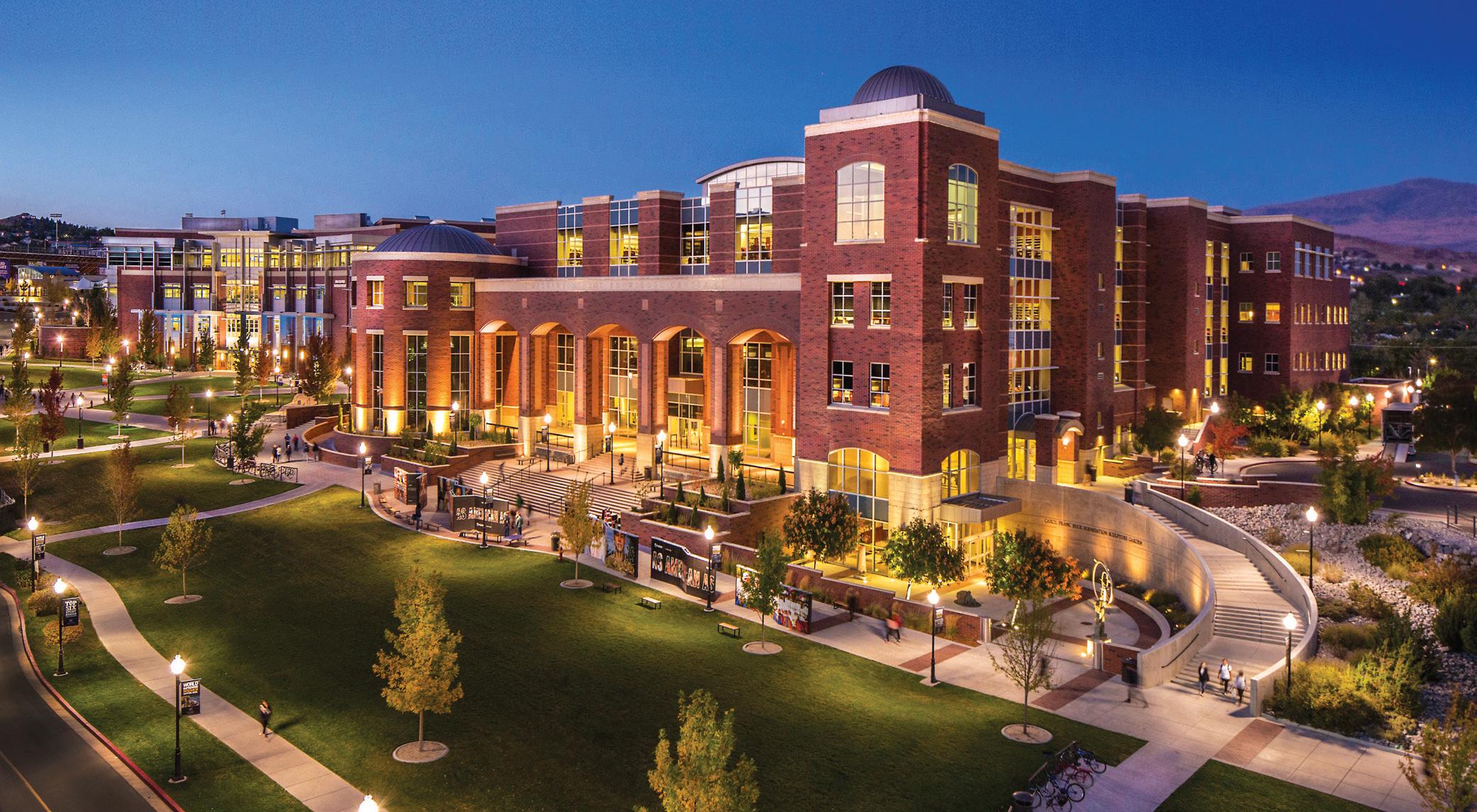
OUR MISSION
Inspired by its land-grant foundation, the University of Nevada, Reno provides outstanding learning, discovery and engagement programs that serve the economic, social, environmental and cultural needs of the citizens of Nevada, the nation and the world. The University recognizes and embraces the critical importance of diversity in preparing students for global citizenship and is committed to a culture of excellence, inclusion and accessibility.
The University of Nevada, Reno Mission Statement remains consistent with the NSHE Mission Statement (Board of Regents Handbook Title 4, Chapter 1, Section 1.)
OUR VALUES
In all of its activities, the University is guided by the following values:
Excellence in all of our endeavors
Integrity in all our actions
Inclusiveness of diverse cultures and identities
Collaboration between disciplines and programs and with community partners and stakeholders
■
■
■
■
'23-'27 STRATEGIC PLAN • University of Nevada, Reno 5
ASPIRATIONAL GOALS
Here, excellence is expected
Excellence in all endeavors is one of the University’s core values and as such, requires continued growth and commitment to raising the standard. The following classifications, designations and memberships provide industry guidelines that lay the roadmap for pursuing excellence in higher education.
CURRENT ACHIEVEMENT:
Carnegie R1 and Carnegie Engaged
What it is: The Carnegie Classification has been the leading framework for recognizing and describing institutional diversity in U.S. higher education for the past four decades. Starting in 1970, the Carnegie Commission on Higher Education developed a classification of colleges and universities to support its program of research and policy analysis.
What has been done: In 2018, and again in 2021, as a confirmation of its continued drive forward to excellence, the University was classified as an “R1” institution by the Carnegie Classification of Institutions of Higher Education. An R1 designation by Carnegie is reserved for doctoral universities with the highest levels of research activity. The University’s work at building research and graduate programs in search of becoming among the best high-impact research universities in the nation has led to important gains that have strengthened the quality, breadth and impact of the University’s research and graduate education endeavors. In 2020, the University achieved the prestigious Carnegie Classification for Community Engagement. Increased collaboration with community and statewide partners, significant co-curricular growth with record student involvement in the community through civic engagement and the maturation of the delivery of services and expertise of faculty, students and staff through cutting-edge initiatives are high-level examples of ways the University has demonstrated dedication to community engagement. Recognition as a “Carnegie Engaged” institution reaffirms the University’s commitment to serving and meeting the needs of Nevada as part of the land-grant mission.
The outcome: These classifications are not the end goal as there is always opportunity for growth in the University’s ability to perform at the highest level in research activity and civic engagement. Therefore, the University will continue to build off of these accomplishments and set even higher standards for its obligations to learning, discovery and engagement.
NEAR-TERM GOAL (3-5 YEARS):
MSI Designations
What it is: Minority-Serving Institution (MSI) designations from the U.S. Department of Education recognize higher education institutions that categorically or historically enroll a specific racial/ ethnic group. Most importantly, these institutions exhibit a dedication to serving minority populations through their mission and day-to-day operations. MSIs can take form as Historically Black Colleges and Universities (HBCUs), Hispanic-Serving Institutions (HSIs), Tribal Colleges and Universities (TCUs) and Asian American and Native American Pacific IslanderServing Institutions (AANAPISIs).
What has been done/needs to be done: The University of Nevada, Reno has embarked on the achievement of HSI and AANAPISI designations based on the current demographics and anticipated future enrollment trends of the undergraduate student body. Accredited institutions with at least 25% total full-time enrollment of Hispanic undergraduate students are eligible for HSI designation and those with at least 10% total full-time enrollment of Asian American and Native American Pacific Islander undergraduate students are eligible for AANAPISIs designation. This only tells part of the story of what the University must do.
6 WOLF PACK RISING
The demographics of Nevada students continue to evolve and diversify with 44% of high school seniors identifying as Hispanic or Latino and 8% as Asian or Native American Pacific Islander in the 2021-22 academic year. The University is implementing recommendations from the Minority Serving Institution (MSI) to improve recruitment of historically underserved students to achieve these designations. Increased retention of all students, with additional focus on historically underserved students and students eligible for Pell and other need-based aid, in addition to active and successful recruitment of more faculty and staff from these historically underserved groups is also a key driver in this effort.
The outcome: Achieving MSI designations will further enable the University to better serve the needs of all students within Nevada and beyond, and demonstrate our commitment to closing opportunity and equity gaps in higher education. Furthermore, it puts the University in a position to compete for federal and private grants earmarked for MSIs to strengthen our current academic and service offerings.
LONG-TERM GOAL (7-15 YEARS):
AAU Invitation
What it is: The Association of American Universities (AAU), founded in 1900, is an organization comprised of 65 research-intensive member institutions leading in education, research and innovation. Its purpose is to be a leading example in higher education, setting institutional and national standards that encourage top-tier academic research, scholarship and education. In 2019, AAU schools received 62% of all federally funded basic research, totaling nearly $28 billion in federal research dollars across the 65 AAU institutions. Membership in the AAU is by invitation only. While there are no set eligibility criteria, membership is based on how an institution’s research and education profile compares to current members. The AAU has identified a set of membership indicators which are used when assessing prospective members.
What needs to be done: This aspirational goal will take a continuous, concerted effort by the University over the coming years to build on current successes while developing deeper capacities in several key areas. They include: competitively funded federal research support, membership in national academies, faculty awards, fellowships and memberships, and citations, as well as doctoral education, number of post-doctoral appointees and undergraduate education. Recent membership in the AAU has included institutions that have placed an increased emphasis in student success, funding of research programs with significant regional engagement, historic increases in sponsored project funding and continued student achievement and faculty renown. Positioning the University in the coming years as being at the forefront of scientific inquiry and educational excellence will be critical in reaching possible AAU status.
The outcome: The AAU is revered as one of the most elite organizations in higher education. Achieving AAU status would affirm the University's continued commitment to its vision – to educate and graduate the best-prepared, confident leaders; to be a nexus for research; and to serve as a catalyst for the betterment of our society.
PELL-ELIGIBLE UNDERGRADS FALL 2021 ■ Non Pell-eligible students 12,676 74% ■ Pell-eligible students 4,349 26% Total 17,025 AANAPISI threshold: 10% AANAPISI current* 9.3% Hispanic threshold: 25% HSI current* 23.4% *Undergraduate students *Undergraduate students '23-'27 STRATEGIC PLAN • University of Nevada, Reno 7
PLANNING TO SUCCEED
Our planning process
OUR STEERING COMMITTEE
Data-driven
WORKING GROUP
OUR WORK PRODUCT
loop
all areas
Each Working Group member provided critical insights from their respective backgrounds and positions on campus, ensuring that the Steering Committee, comprised of our University’s senior leadership, received robust and comprehensive recommendations for key decision points. Most importantly, the Working Group’s thoughtfulness resulted in a strategic plan that represents the entirety of the University’s community and reflects a road map that is simultaneously challenging and achievable, while laying the groundwork for our University’s long-term success.
WORKING GROUP
Zach Behl, Fiscal and HR Officer School of Social Work
Carolyn Brayko, PhD, Director Institutional Effectiveness University of Nevada, Reno, School of Medicine
Austin Brown, President Associated Students of the University of Nevada, Reno
Catherine Cardwell, Dean of Libraries
Christopher Coake, Associate Professor of English
Donald Easton-Brooks, PhD, Dean of College of Education and Human Development
Marta Elliott, PhD, Professor of Sociology
Eloisa Gordon-Mora, PhD, University Diversity and Inclusion Officer
Matthew Hawn, President Graduate Student Association
Jack Hayes, PhD, Professor of Biology
Kerri Garcia Hendricks, Executive Director of Marketing and Communications
Ahmad Itani, PhD, Foundation Professor and Associate Vice President for Research
Jean Jeon, PhD, Associate Professor of Marketing
Leilani Kupo, PhD, Dean of Students
Steve Maples, PhD, Director of Admissions
Eric A. Marchand, PhD, Associate Professor of Civil and Environmental Engineering
Leslie Nady, Chief of Staff Office of the Provost
Shawn Norman, Associate Vice President for Planning, Budget & Analysis
Mark Riddle, M.D., Dr.P.H., Professor and Associate Dean of Clinical Research, University of Nevada, Reno School of Medicine
Jill Short, Chair Staff Employees Council
Wei Yang, M.D., Associate Dean and Foundation Professor of Public Health
KEY INPUTS & DATA SOURCES
NSHE goals and objectives
Presidential goals and objectives
32 listening sessions with faculty, staff and students across campus
400+ ideas from faculty, staff, students, alumni, and the greater Reno-Tahoe community
Interviews with University leadership, key internal and external stakeholders
12 campus previews
Higher education trends
Strategic planning best practices
Peer universities comparison
85% of alumni surveyed agree these goals are the right direction for the University.
■
■
■
■
■
■
■
■
■
•
• Collaborative • Campuswide OUR
• 21 working group members • Diverse • Feedback
to
• Curated inputs • Wrote the plan • Shared widely • Achieved consensus
8 WOLF PACK RISING
LISTENING SESSIONS FOR CAMPUS INPUT
Faculty, Administrative Faculty and Staff
■ Faculty Senate
Academic Faculty
Classified Staff
Administrative Faculty
Staff Employees’ Council
Student listening sessions
Graduate Student Association
ASUN
■ Student Body Listening Sessions
Colleges and Schools
Business
Libraries
Engineering
Agriculture, Biotechnology & Natural Resources
Science
Education & Human Development
Journalism
Public Health
Social Work
Medicine
Liberal Arts
Nursing
STRATEGIC PLANNING TIMELINE
Phase 1: Mobilize (Sept.-Oct. 2021)
Kick-off the project and identify key stakeholders for steering committee and working group
Phase 2: Assess (Sept.-Dec. 2021)
Conduct a situational analysis to assess external environmental trends and internal capabilities, differentiators and challenges
Phase 3: Ideate (Oct. 2021.-Jan. 2022)
Develop and share initial goals, strategies and actions
Phase 4: Iterate and Design (Nov. 2021-Mar. 2022)
Engage the University community to collect and respond to feedback for refinement of the strategic plan
Phase 5: Recommend (Mar.-Jun. 2022)
Finalize the draft strategic plan for submission to the NSHE Board of Regents for review and approval
PLAN STRUCTURE
Divisions and Units
President’s Division
Provost’s Division
Administration and Finance
Student Services
Research & Innovation
Advancement
Our strategic plan consists of five components:
■ Our vision, mission and values articulate who we are and what we stand for as a University; provide a vivid, realistic and credible description of the University’s aspirations; and serve as pillars for our success.
■ The goals establish the critical elements that must be delivered for the University to achieve our strategic priorities and fulfill our vision, mission and values.
■ Strategies that support these goals represent principal areas of focus to identify and organize underlying actions.
■ Actions detail the specific efforts that will guide the execution needed to achieve the University’s goals.
■ Directional metrics establish a means to quantify our progress toward expected outcomes and measure our collective success throughout the execution of our plan.
This plan is action-oriented, comprehensive and inclusive, where all University stakeholders can identify how this plan directly affects their individual and collective futures. Additionally, individual University colleges and units will create supporting unit-level strategic plans that align to the University’s strategic plan and guide unit-level activity.
■
■
■
■
■
■
■
■
■
■
■
■
■
■
■
■
■
■
■
■
■
■
■
■
'23-'27 STRATEGIC PLAN • University of Nevada, Reno 9
Our Goals
Our University’s vision, mission and values serve as the foundation upon which this strategic plan sits atop, building off our rich history. The plan features six strategic goals that embody what we stand for as a university and wish to achieve over the next few years.
Every stakeholder group articulated that creating an environment for students, faculty and staff to succeed equitably was fundamental to fulfilling the University’s vision and mission and demonstrating our values. Therefore, the first goal logically became focused on our people while also acknowledging the opportunity for University growth by reaching 23,000 students by 2025 and 25,000 students by 2030.
The University community also communicated the important reality that to enable growth, investments must be made in the people and spaces that make our University great, which led to our second goal. A third key theme that naturally evolved into a strategic goal was the broad emphasis on expanding the University’s ties with the broader community to better deliver our land-grant mission and serve Nevada. This third goal enables the University to build upon our designation, first achieved in 2020, as Carnegie Engaged by the Carnegie Foundation for the Advancement of Teaching.
An important accomplishment in the University’s history, as communicated through nearly all listening sessions, was achieving in 2018 the classification of “very high research activity” by the Carnegie Foundation for the Advancement of Teaching, recognizing our place among the top 150 universities in the country for research activity. Therefore, the fourth goal elucidates the desire to build on the University’s Carnegie status and position our University on par with the public, land-grant members of the Association of American Universities (AAU), a group of 64 leading universities in the United States and Canada.
The University community also made clear the criticality of continuing and expanding upon our leadership in policy, action, education and research for environmental sustainability, both on campus and in the broader Lake Tahoe region, thereby logically leading to our fifth goal. Finally, the University community emphasized the importance of recognizing that the efforts and successes of our campus should be shared with and amplified around the world.
Through the sixth and final goal which is focused on strengthening our reputation, brand and alumni engagement, the University's "paw" print will extend beyond the state's borders.
The first goal logically became focused on our people while also acknowledging the opportunity for University growth by reaching 23,000 students by 2025 and 25,000 students by 2030.

10 WOLF PACK RISING SIX STRATEGIC GOALS
GOAL 1
STRENGTHEN THE PACK
Enable inclusive excellence for students, faculty and staff
Strategy 1. Increase equitable student outcomes while growing enrollment to 25,000 by FY2030

Strategy 2. Become a career destination for diverse faculty and staff
This goal focuses on enhancing equity in opportunities, experiences and outcomes for our people – the students, faculty, & staff.
GOAL 2
INVEST IN OUR FUTURE
Deliver the services, organization and infrastructure required to support a growing University Strategy 1. Enable our success with an agile organizational model and leading business operations
Strategy 2. Deliver the physical and technological infrastructure necessary to support our future
In order to support our growing University, we must invest in and deliver the services, organization, infrastructure and physical spaces required to enable growth.
GOAL 3
LEAD FOR NEVADA

Enhance the delivery of our land-grant mission Strategy 1. Enrich our academic portfolio Strategy 2. Increase service to and collaboration with communities across the state
Educational services, community engagement and workforce development are all areas in which the University can expand its efforts beyond campus to enhance the delivery of the land-grant mission and better serve the people of Nevada.
GOAL 4
TRANSFORM THE WORLD
Elevate our top-tier research and contributions

Strategy 1. Progress toward becoming a top 100 R1 institution and a top 50 NSF public research and development university Strategy 2. Move toward achieving American Association of Universities’ membership indicators
To become a leader in higher education, we must embrace our top-tier research, innovation and entrepreneurship contributions. Working towards membership in the American Association of Universities will better equip the University to transform the world.
GOAL 5
MAKE SILVER & BLUE THE NEW GREEN
Lead in environmental expertise and campus sustainability Strategy 1. Establish Reno-Tahoe as an epicenter of sustainability education, research and leadership Strategy 2. Amplify our environmental sustainability, biodiversity and climate change leadership
We will expand our leadership in policy, action, education and research for environmental sustainability, both on campus and globally.
GOAL 6
EXPAND THE WOLF PACK IMPACT
Reinforce our impact to Nevada and beyond Strategy 1. Strengthen the University’s reputation and brand recognition nationally and globally Strategy 2. Enhance connections to and pride in The Wolf Pack Way
The Wolf Pack Way is a value system demonstrated by our students, faculty, staff and alumni as we make positive contributions to our communities throughout the world. Expanding on this reinforces our impact to Nevada and beyond, and strengthens connections with constituents beyond campus.
'23-'27 STRATEGIC PLAN • University of Nevada, Reno 11
GOAL 1: STRENGTHEN THE PACK
Goal 1: Strengthen the Pack
Enable inclusive excellence for our students, faculty and staff
Increase equitable student outcomes while growing enrollment to 25,000 by FY2030STRATEGY 1
ENROLLMENT
A. Provide access for all of Nevada’s students and be a compelling choice for Nevada’s most academically prepared students
B. Deploy a data-driven framework that identifies and resolves inhibitors to equitable success and addresses the opportunity gaps throughout the lifecycle (e.g., admissions, retention, etc.) from prospective students to alumni
C. Assess undergraduate student demand trends to identify opportunities to invest in target markets, both in-state and beyond, and achieve related growth-oriented success metrics
D. Identify opportunities to grow graduate enrollment by determining areas of opportunity and removing inhibitors (e.g., stipends, enrollment caps, recruiting resources, etc.)
E. Execute the University’s DEI Strategic Action Plan to increase diversity, equity, inclusion and access in recruitment, matriculation and persistence to seek recognition by the US Department of Education as a Hispanic Serving Institution (HSI) and an Asian American, Native American and Pacific Islander Serving Institution (AANAPISI)
F. Establish an office to grow partnerships with other institutions and improve the transfer process, focusing on Nevada two-year institutions and international students

G. Pursue partnerships with Historically Black Colleges and Universities (HBCUs) and other Minority Serving Institutions (MSIs) to build pipelines for graduate degree programs
EXPERIENCE
H. Strengthen support programming for diverse groups as recommended by the MSI taskforce and provide educational resources for students on the comprehensive benefits of enabling a diverse, equitable and inclusive environment
I. Collaborate with local and state Tribes’ leadership to promote their heritages and strengthen ties with the University community
J. Attract and maintain a highly qualified and diverse group of undergraduate academic advisors to serve students and career advisors/services to empower students for success after graduation
K. Assess effectiveness of undergraduate advising and student success support to enhance resources and programming for students
L. Increase accessibility to childcare, housing, transit, mental health and wellness resources, affordable healthcare and food insecurity services for all students
M. Collaborate with student leadership to formalize communication channels for student feedback on the student experience to leadership
N. Implement the internationalization committee’s recommendations to increase international exchange and experience opportunities, including study abroad
O. Expand undergraduate research opportunities equitably for all students in all fields of study
12 WOLF PACK RISING
23,000
enrollment of first-year, in-state students, including total first-year enrollment to 4,000 by Fall 2027
Increase transfer students to 1,500 total enrollment by Fall 2027
Increase freshman retention to 87% by Fall 2027
Increase retention rates for all students in total and for all minority student
Increase six-year graduation rate to 65% for Fall 2021 cohort
Achieve U.S. Department of Education designations of Hispanic-Serving Institution and Asian American, Native American and Pacific Islander-Serving Institution by Fall 2027
Maintain at a minimum or outperform the NSHE required student-to-advisor ratio of 350:1
❑ Enroll
total student headcount by Fall 2025 ❑ Increase
❑
❑
❑
cohorts STUDENTS GOAL 1 Strategy 1 Directional Outcomes / Metrics ❑
❑
❑
TOTAL HEADCOUNT | FALL 2021 ■ Undergraduate 17,025 81% ■ Graduate 3,671 17% ■ Medical 338 2% Total 21,034 Fall 2021 Student-to-Faculty Ratio 19:1 Fall 2021 Student-to-Advisor Ratio 350:1 '23-'27 STRATEGIC PLAN • University of Nevada, Reno 13 HEADCOUNT BY RESIDENCY FALL 2021 IN-STATE HEADCOUNT | FALL 2021 Out-ofState 5,854 28% In-State 15,180 72% Washoe 8,184 54% Clark 4,869 32% Rural 2,127 14%
GOAL 1: STRENGTHEN THE PACK
STRATEGY 2 Become a career destination for diverse faculty and staff
A. Increase the number of faculty and staff as required to support projected enrollment growth and educational demand
B. Develop a performance pay model and reward structure to recognize achieved goals and objectives
C. Identify gaps in salary parity and establish a roadmap to achieve compensation equity
D. Adjust, where possible, performance evaluation criteria to include strategic priorities, including, but not limited to, recognition of teaching; research; service; DEI engagement; creative activity; and recruiting, hiring and mentoring metrics
E. Increase faculty and staff diversity to achieve alignment with the National Association of System Heads (NASH) Equity Action Framework on hiring, retention, promotions and rewards best practices
F. Embed teaching and classroom management skills into the faculty development program that promote mindfulness of the University’s values, DEI and the freedom of critical thought and expression
G. Enhance internal communication efforts between faculty, staff and administration, as well as across campus units, using a variety of channels and technology
H. Invest in formalized professional development for faculty and staff, with attention to discipline-specific instructional programming
I. Increase access to resources for faculty and staff for coordinated mental health and wellness, childcare, housing, transit and food insecurity services
J. Develop and execute a strategy for assessing faculty and staff engagement and morale to identify strengths and opportunities for improvement
GOAL 1 Strategy 2 Directional Outcomes / Metrics
FACULTY AND STAFF
Launch a performance pay model by FY2023
Increase retention rates for all faculty and staff
Increase annual engagement and sentiment scores for faculty and staff
Maintain or decrease existing student-faculty ratio of 19:1 concurrent with expected enrollment growth
14 WOLF PACK RISING
❑
❑
❑
❑
ACADEMIC FACULTY ETHNICITY
FALL 2021
ADMINISTRATIVE FACULTY/STAFF ETHNICITY
FALL
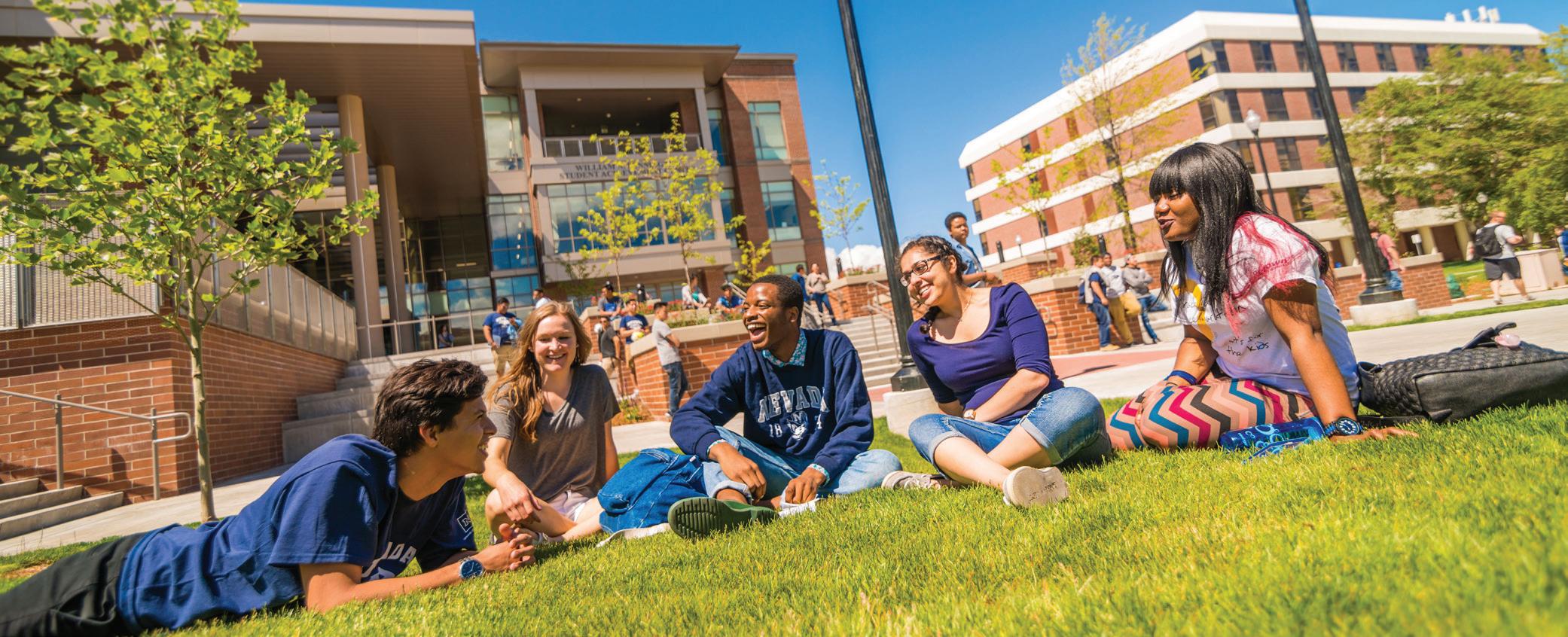
'23-'27 STRATEGIC PLAN • University of Nevada, Reno 15
|
2021 ■ American Indian Alaska Native 57 <1% ■ Asian 826 13% ■ Black 265 4% ■ Hispanic/Latinx 975 15% ■ Multi 268 4% ■ Pacific Islander 27 <1% ■ Unknown 87 1% ■ White 4,072 62% Total 6,577
|
■ American Indian Alaska Native 5 <1% ■ Asian 167 15.5% ■ Black 22 2% ■ Hispanic/Latinx 77 7% ■ Multi 19 2% ■ Pacific Islander 2 <1% ■ White 783 73% Total 1,075
2: INVEST IN OUR FUTURE
Goal 2: Invest in our future
Deliver the services, organization and infrastructure required to support our growing University
STRATEGY 1 Enable our success with an agile organizational model and leading business operations
A. Identify potential benefits of and investments required to improve the University’s efficiency and effectiveness, potentially including shared services to optimize administrative functions and execute leadership initiatives (e.g., human resources, budget and finance, IT, marketing and communications, etc.)
B. Implement enhanced budget and revamped recruitment and retention HR model to enable a more proactive campus that improves responsiveness to dynamic priorities and needs
C. Assess the University’s organization structure against leading public land-grant research institutions to identify potential adjustments required to enable future growth
D. Create an implementation plan that incorporates the requisite changes to and investments in policy, business processes, organization and resources to improve University service and operations
Deliver the physical and technological infrastructure necessary to support our futureSTRATEGY 2
A. Identify the infrastructure and associated investments necessary to support a top-tier research University, including IT infrastructure, hardware and software; data systems; libraries; creative spaces; and classrooms/labs
B. Identify opportunities for space optimization with a Facilities Master Plan that identifies the strategic infrastructure and capital resources needed for education, research, IT administration, creative activity, athletics, childcare, parking and student housing
C. Implement principles of inclusive design for all new and modified physical and digital spaces
D. Provide the technological resources to achieve digital equity across the University community including expanding the Digital Wolf Pack Initiative
E. Finalize the design and build of the new College of Business and Life Sciences buildings
F. Maintain the facilities and infrastructure required to enable individual student-athlete and team athletic excellence across all sports
16 WOLF PACK RISING GOAL
GOAL 2
Directional Outcomes / Metrics
Publish a new Campus Master Plan by FY2023

Develop a policy, process and organizational change implementation plan by FY2024
Implement a flexible and dynamic budget model by FY2025
Implement a responsive recruitment and retention approach
Implement recommendations from organizational assessment by FY2025
UNIVERSITY OF NEVADA, RENO
CAMPUS
RENO/SPARKS AREA (OFF-CAMPUS)
square
of
of
OF NEVADA (OUTSIDE RENO/SPARKS)
square feet of buildings
of land
NOTES
Campus: McCarran to Evans to 9th to Sierra (properties across Evans, Valley Road and Gateway south of 9th are part of greater Reno/Sparks calculation)
leased space/buildings that UNR/NSHE does not own; non-University of Nevada, Reno owned buildings on campus (i.e. Nevada Historical Society, PBS Reno, etc.)
❑
❑
❑
❑
❑
MAIN
■ 6,529,888 gross square feet of buildings ■ 247 acres of land
■ 724,160 gross
feet
buildings ■ 1,240 acres
land STATE
■ 117,486 gross
■ 19,938 acres
Main
Excluded:
'23-'27 STRATEGIC PLAN • University of Nevada, Reno 17
Goal 3: Lead for Nevada
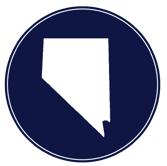
Enhance the delivery of our land-grant mission
STRATEGY 1 Enrich our academic portfolio
A. Increase support for and emphasis on interdisciplinary instruction, experiential learning, and entrepreneurial and creative activity
B. Emphasize career preparedness across the academic curriculum and within advising to bridge skill gaps for students
C. Identify opportunities for and invest in programmatic growth by conducting a comprehensive competitive assessment of academic programs
D. Establish a comprehensive online education strategy to complement the on-campus quality of education and deliver a consistent, engaging student experience
E. Increase focus on social justice, diversity, equity and inclusion issues in the curriculum
F. Enable the implementation of inclusive pedagogies, such as Universal Design for Learning (UDL), throughout the curriculum
G. Explore expanding the Dean’s Future Scholars program with a University-wide approach beyond the College of Education and Human Development
H. Explore opportunities to expand dual-enrollment programs to more K-12 school districts
I. Develop strategic partnerships with other institutions to complement academic offerings and research opportunities
College of Agriculture, Biotechnology and Natural Resources
College of Business
College of Education and Human Development
College of Engineering
Donald W. Reynolds School of Journalism
College of Liberal Arts
University of Nevada, Reno School of Medicine
Orvis School of Nursing
School of Public Health
College of Science
School of Social Work
Graduate School
Honors College
MINORS & CERTIFICATES
Undergraduate 129 Graduate 133 Medical 1 Minors 265 Certificates 32 Total 560 DEGREES,
OFFERED | FALL 2021
•
•
•
•
•
•
•
•
•
•
•
•
•
UNIVERSITY OF NEVADA, RENO Number of colleges and schools 13 18 WOLF PACK RISING GOAL 3: LEAD FOR NEVADA
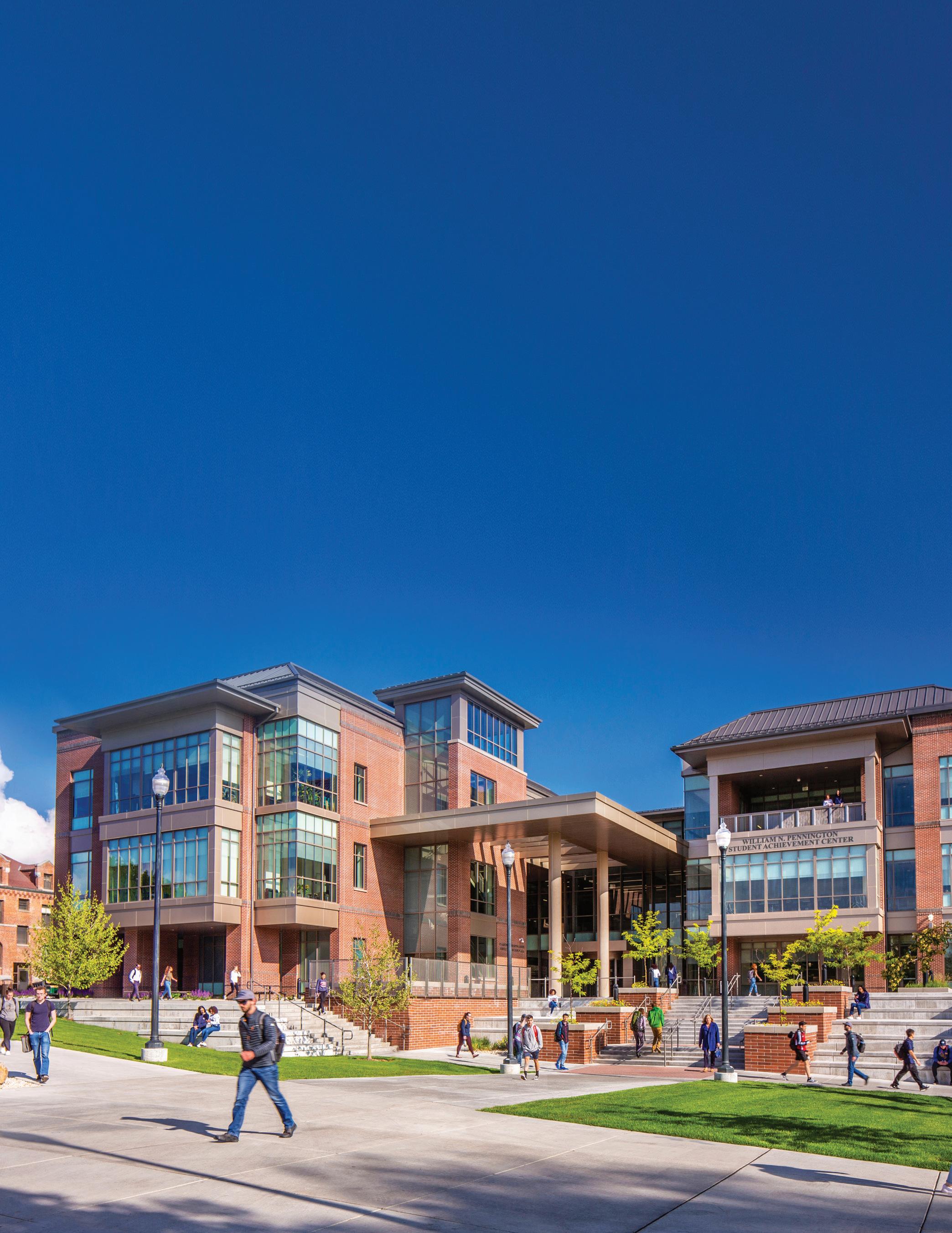
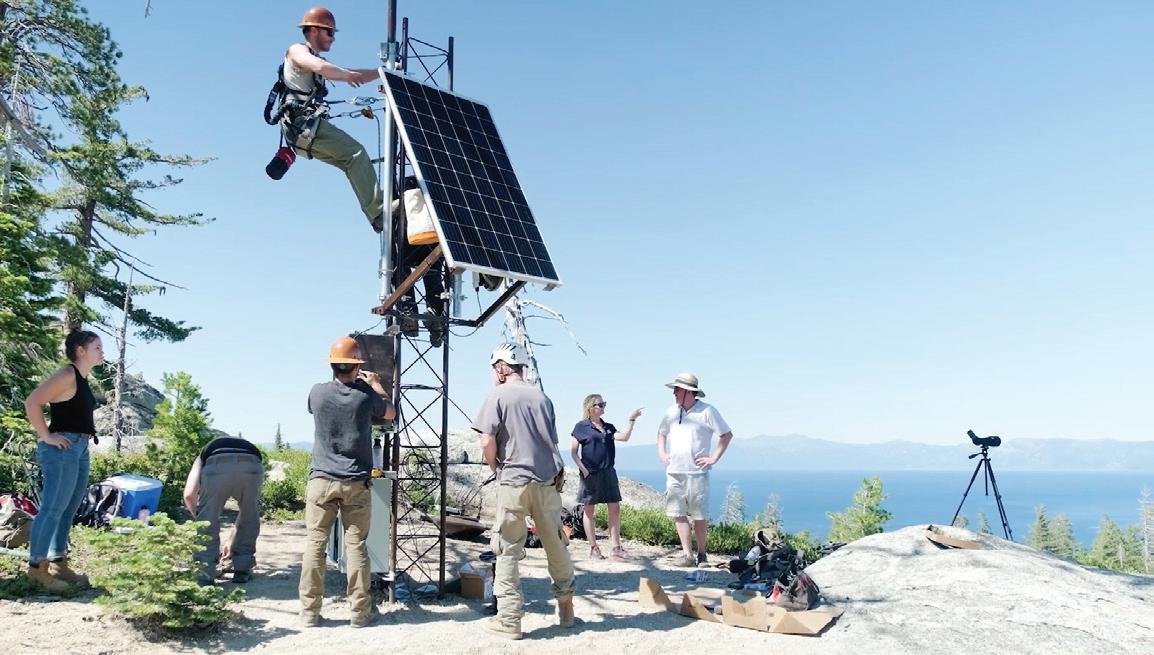


'23-'27 STRATEGIC PLAN • University of Nevada, Reno 19
GOAL 3: LEAD FOR NEVADA
STRATEGY 2 Increase service to and collaboration with communities across the state
A. Increase partnerships with local community leaders and organizations to increase access to healthcare and drive civic engagement locally and across the state
B. Enhance Nevada’s community-focused health programs through engagement and leadership
C. Establish a physical footprint and academic, research, arts, library and service offerings in the Lake Tahoe area
D. Promote the University's archives, museums, libraries, music and theatre performances and science centers to enrich the lives of Nevadans, the University’s community and visitors
E. Identify opportunities to expand offerings, both degree and non-degree, to serve Nevada’s education, creative and workforce development needs
F. Enhance the growth of an entrepreneurial ecosystem by collaborating with industry and government agencies to accelerate economic and workforce development in Nevada
G. Explore formal and informal community partnerships to maximize economic impact of students' volunteer efforts in Reno-Lake Tahoe
H. Expand the partnership with Renown Health to advance health and health care through worldclass medical education, clinical research and patient care for the Reno-Sparks-Lake Tahoe community and Nevada
I. Build upon affiliation with the Kenny Guinn Center for Policy Priorities to provide expertise on a broad range of public-policy issues that are critical to Nevada and the nation
J. Enhance partnerships between athletics and the Reno-Sparks and Lake Tahoe communities to drive community engagement, including with local schools and Boys and Girls clubs, among others, and serve as an important asset for the state of Nevada
GOAL 3 Directional Outcomes / Metrics
attendance
with Nevadans through community-focused programs for health, civic engagement
workforce development
number of employers participating in workforce development
increase the internship
placement rates for
❑ Reaffirm Carnegie Community Engaged designation ❑ Develop and begin executing the University-wide online strategy by Spring 2023 ❑ Create a bridge program to increase enrollment pathways for Nevadans ❑ Increase number of faculty members trained on and courses employing inclusive pedagogies (i.e., UDL)
❑ Increase the
at or engagement
and
and training ❑ Increase
programs ❑ Equitably
and job
all students 20 WOLF PACK RISING

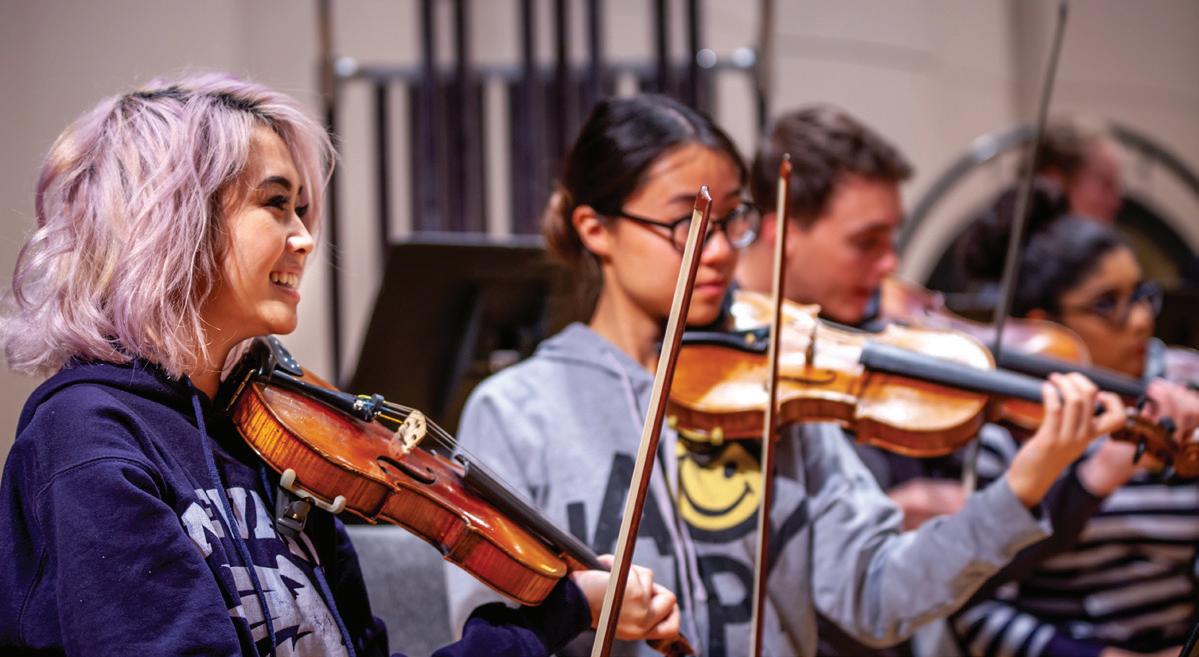


'23-'27 STRATEGIC PLAN • University of Nevada, Reno 21
4: TRANSFORM THE WORLD
Goal 4: Transform the world
Elevate our top-tier research and contributions

STRATEGY 1 Progress toward becoming a top 100 R1 institution and a top 50 NSF public research and development university
A. Establish a multi-disciplinary task force to identify gaps and associated investments needed in programmatic, physical and technological requirements; utilize findings to expand and modernize core research facilities and infrastructure, and achieve research objectives
B. Leverage partnerships with Renown, VA and other community health partners to increase opportunities for clinical and translational research, residency programs, internships and fellowships
C. Expand external partnerships to increase research, creative and innovation opportunities, including driving research efforts within Nevada and the southwest region
D. Establish a centralized focus group that promotes interdisciplinary research and scholarship
STRATEGY 2 Move toward achieving American Association of Universities’ membership indicators
A. Launch a working group to identify actions required to mitigate gaps to and guide the University's progress towards demonstrating achievement of current AAU indicators
B. Assess the existing policies, processes and systems to identify priorities for optimizing growth across research and creative activities
C. Establish a framework to objectively allocate resources to research programs
D. Formalize a process for providing faculty the world-class infrastructure, resources, mentorship and support needed to receive honorific awards, fellowships and membership in national academies
E. Develop a prioritization plan for hiring graduate research assistants and graduate teaching assistants that identifies existing, future and target candidate programs
22 WOLF PACK RISING GOAL
GOAL 4 Directional Outcomes / Metrics
Maintain Carnegie “very high research activity” classification
Increase federally funded research grant applications and awards annually

Increase applications for and awards of federal grants specific to the National Science Foundation’s public research rankings
Increase number of faculty honorific awards, fellowships and memberships
Increase the number of faculty invited to membership into the national academies
Increase the number of graduate research assistants and teaching assistants annually
Increase the number of non-tenure track research faculty and post-docs each year to achieve a minimum of 250
RESEARCH EXPENDITURES 2021
Increase the number of tenure / tenuretrack faculty positions each year to achieve a minimum of 900 by 2027
Increase the number of journal citations from University faculty each year
Increase research expenditures to $250M in total and $18M total outside of science and engineering
Increase Ph.D. graduates to 200, including 115 STEM; 20 Humanities; 22 Social Sciences; and 45 Others (Professional Degrees)
Achieve ranking as one of the top 50 NSF public research and development universities
■ U.S. Federal Government $77,245,870 44% ■ All other sources $98,140,597 56% Total $175,386,467
❑
❑
❑
❑
❑
❑
❑
❑
❑
❑
❑
❑
'23-'27 STRATEGIC PLAN • University of Nevada, Reno 23
Goal 5: Make Silver & Blue the new green
Lead in environmental expertise and campus sustainability
A. Enhance our interdisciplinary centers for research, education, advocacy of climate change, water preservation, drylands agriculture and environment sustainability
B. Partner with community organizations, leveraging proximity to Lake Tahoe, to provide sustainable tourism education
C. Extend on a global scale the faculty’s proven thought leadership on the impacts of climate change, including those specific to Nevada and western states, as well as international concerns (i.e., fires, droughts, clean water scarcity, earthquakes, etc.)
D. Retain and add to the University’s environmental sustainability-related external designations, such as Tree Campus USA, Bicycle Friendly University designation, among others
A. Develop an action plan to decrease the University’s carbon footprint and make progress towards achieving an Association for the Advancement of Sustainability in Higher Education (AASHE) Sustainability Tracking, Assessment & Rating System (STARS) rating
B. Embed sustainability within the University’s policies, procedures and operations, beginning with updating the University’s environmental and sustainability policies
C. Establish an advisory body that includes students, faculty, staff and local leaders to inform sustainability efforts
D. Increase access to and incentivize the use of ecofriendly modes of transit on campus and around the Lake Tahoe region
E. Assess embedding Leadership in Energy and Environmental Design (LEED) principles into the development or modification of physical spaces on campus
F. Establish the University as a research and policy leader in sustainability in the mountain west region
G. Partner with nonprofit policy centers and institutions to inform government agencies and educate and train undergraduate and graduate students in environmental and public land policy
STRATEGY 1 Establish Reno-Tahoe as an epicenter of sustainability education, research and leadership
Amplify our environmental sustainability, biodiversity and climate change leadershipSTRATEGY
2 24 WOLF PACK RISING GOAL 5: MAKE SILVER & BLUE THE NEW GREEN
GOAL 5 Directional Outcomes / Metrics

❑ Complete an update of the University’s environmental sustainability policies by FY2023 ❑ Begin STARS reporting to AASHE by FY2025 ❑ Decrease the University’s greenhouse gas emissions to mitigate climate change ❑ Increase the number of climate-specific media segments or publications featuring faculty and/or staff ❑ Increase number of and enrollment/ attendance at programs offered through interdisciplinary center
'23-'27 STRATEGIC PLAN • University of Nevada, Reno 25
EXPAND THE WOLF PACK IMPACT
Goal 6: Expand the Wolf Pack Impact
Reinforce our impact to Nevada and beyond
STRATEGY 1 Strengthen the University’s reputation and brand recognition nationally and globally
A. Perform a comprehensive study to assess the University’s brand positioning to identify and address gaps, and improve brand recognition
B. Devise and deploy a marketing campaign for national and international exposure of the University’s academic and research accomplishments
C. Leverage our notable alumni as a means of increasing brand awareness
D. Implement the ACE Internationalization Lab Committee’s recommendations to enhance the University's global engagement and international reputation, and develop a centralized, institutional vision for internationalization efforts and initiatives
E. Enhance international profile of the athletics department and student-athlete alumni to highlight transformative contributions within and outside of sports to the University, state of Nevada, the country, and the world
2 Enhance connections to and pride in The Wolf Pack Way
A. Develop a student and alumni engagement plan to increase affinity and lifelong connections, as well as develop a culture of ongoing alumni community and philanthropy
B. Identify opportunities to enable alumni-to-alumni engagement and alumni-to-student interactions to improve the overall campus experience, enhance student success and enhance lifelong connections to campus and the University
C. Recognize alumni and University achievements by extending the on-campus Wolf Pack Way through digital technology and other forms of media to reinforce our impact across the state, nation and world
D. Assess opportunities to better serve alumni and improve the University’s continued investment in the Wolf Pack post-graduation through lifelong learning and other engagements
GOAL 6 Directional Outcomes / Metrics
Increase the number of local, regional and national interviews and published stories featuring University faculty, staff, administrators and students
Increase brand perception score
Increase the alumni giving rate
Increase the alumni engagement rate
STRATEGY
❑
❑
❑
❑
26 WOLF PACK RISING GOAL 6:




'23-'27 STRATEGIC PLAN • University of Nevada, Reno 27
University without borders
University of Nevada, Reno School of Medicine
Established in 1969, The University of Nevada, Reno School of Medicine was the Silver State’s first medical school. Over the years, 1,693 medical doctors have graduated and gone on to serve our state, nation and world. One-third of graduates are currently practicing in Nevada, providing access to healthcare for Nevada’s citizens. In total, more than 3,400 physicians (MDs and UNR Med GME program physicians) have been trained in both undergraduate and graduate medical education programs, enhancing a healthy Nevada for everyone. In 2021, the medical school, the NSHE Board of Regents and Renown Health finalized a 50-year affiliation to build “A Healthy Nevada” and advance the state’s health care through world-class medical education, clinical research and patient care. The agreement establishes Nevada’s first integrated health care system where institutions’ clinical practice, teaching and clinical research programs will be combined into one seamless operation. The aim is to improve Nevadans’ access to care, create new clinical training programs, increase student class sizes and expand research, clinical trials and health care-related employment opportunities.
courses—at a discount—while still enrolled in high school. By doing so, students can graduate from the University of Nevada, Reno in three years.
The University of Nevada, Reno Collegiate Academies are now active in Centennial High School and Cheyenne High School in Las Vegas. By creating these dualenrollment opportunities, high school students can get a sense for what college classes and teaching methods are really like, and by "sampling" the academic offerings of the University of Nevada, Reno, students may ultimately feel more comfortable enrolling here and completing their bachelor's, master's or doctoral degree programs as part of the Wolf Pack Family.
The Digital Wolf Pack Initiative

The University of Nevada, Reno partnered with Apple® to create the Digital Wolf Pack Initiative, a program that provides a common learning platform and equal

University of Nevada, Reno Collegiate Academies
The University has created Collegiate Academies at several Nevada high schools, offering those students the opportunity to complete a year or more of college
28 WOLF PACK RISING KEY INITIATIVES AND ENGAGEMENT
access to technology and digital tools for new, degree-seeking students and faculty. In 2021, more than 3,000 new freshmen received an iPad, keyboard and stylus at no cost to them. The University funded the Digital Wolf Pack Initiative from its investment portfolio.
Sierra Nevada University gift creates University of Nevada, Reno at Lake Tahoe
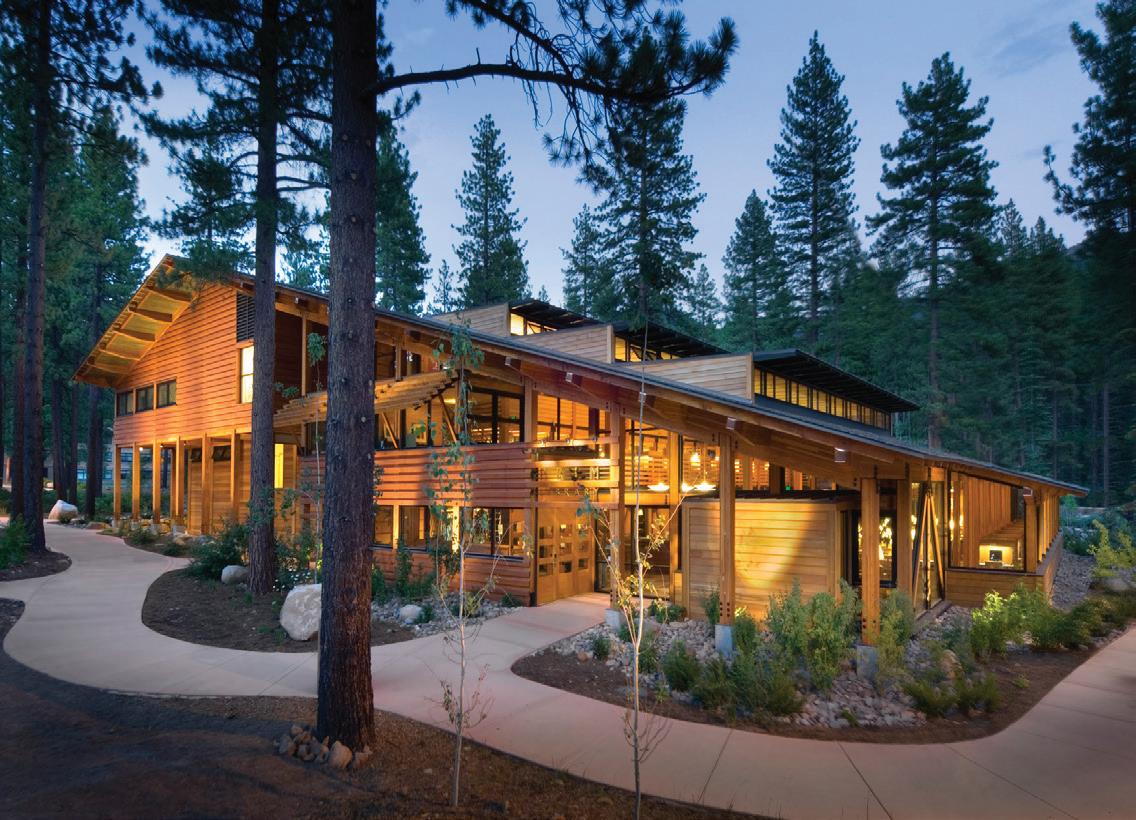
In July 2021, the Board of Trustees of Sierra Nevada University and NSHE Board of Regents approved a gift agreement allowing Sierra Nevada University to become a part of the University of Nevada, Reno, which will be known as the University of Nevada, Reno at Lake Tahoe. When programs and operations have merged, the University will welcome a diverse group of students, faculty and staff to the shores of Lake Tahoe in Fall 2022.
The Wolf Pack Way
In 2021, a major pedestrian path through campus was lined with light-pole banners featuring outstanding graduates doing great work all over the world. The path, dubbed The Wolf Pack Way, features an inaugural “class” of 75 alumni, and the University plans to add more as the path extends roughly a mile from the main University entrance all the way to Mackay Stadium on the north end of campus.

Deans from each of the University’s 13 colleges and schools were asked to choose 10 graduates they felt were inspirational and had gone on to accomplish great things after graduation. The first 75 to be featured were chosen by Provost Jeff
Thompson from these early submissions. The banners will be changed out every few years as new “classes” of alumni make their marks on the world.
At its essence, The Wolf Pack Way is a nod to the University’s original land-grant mission of providing access to education and knowledge, and sharing the benefits of it with Nevada’s citizens, the nation and the world. The Wolf Pack Way also speaks to a culture of caring embodied by our students, faculty, staff and alumni as they make positive contributions to their communities throughout the world, in the spirit of service beyond self.
In 2022, the University worked with the City of Reno to rename Center Street to University Way from the Truckee River to the University’s south entrance. This change will strengthen the University's connection to downtown Reno and make a fitting start to The Wolf Pack Way.
Hundreds of students and other members of the Wolf Pack community walk this path every day headed all over campus. The hope is that the name will catch on at the University and Pack members will aspire to have their own smiling, successful faces be featured on a banner.
'23-'27 STRATEGIC PLAN • University of Nevada, Reno 29
Building for the future
There are a number of important capital construction projects that are either nearing completion, or are in predesign or in the planning phases. When taken together these projects promise to position the University for future success.
Argenta Hall re-opening
One of the campus’ prime residential communities, Argenta Hall, is scheduled to re-open in August 2022. Argenta, which has been offline following a boiler explosion in July 2019, has had a successful renovation that has included its first floor and Downunder Dining Commons, a state-of-the-art dining area for resident and campus use. The building has also been updated with room remodels, new carpeting and laundry service.
Gateway District
The Mathewson University Gateway is a long-awaited extension of the University that is bordered by Interstate 80 on the south, 9th St. on the north, North Virginia St. on the west and Lake Street on the east. Working together, the University and the City of Reno have shared in a vision that will further enhance downtown revitalization efforts and to permanently embed an ecosystem of knowledge-based innovation and industry in our community.
The creation of the Gateway stretching from campus into downtown emphasizes multi-modal transportation as well as the development of businesses and buildings – including University academic and residential buildings. The Gateway Parking Complex with its ADA compliant pedestrian bridge, is expected to be completed in December 2022 and will add 811 parking spaces for University use. It is one of several planned Gateway construction projects, including a new College of Business building. A major step forward for the Gateway occurred in Fall 2021, when Center Street leading into the University was officially named University Way by the City of Reno and the NSHE Board of Regents.
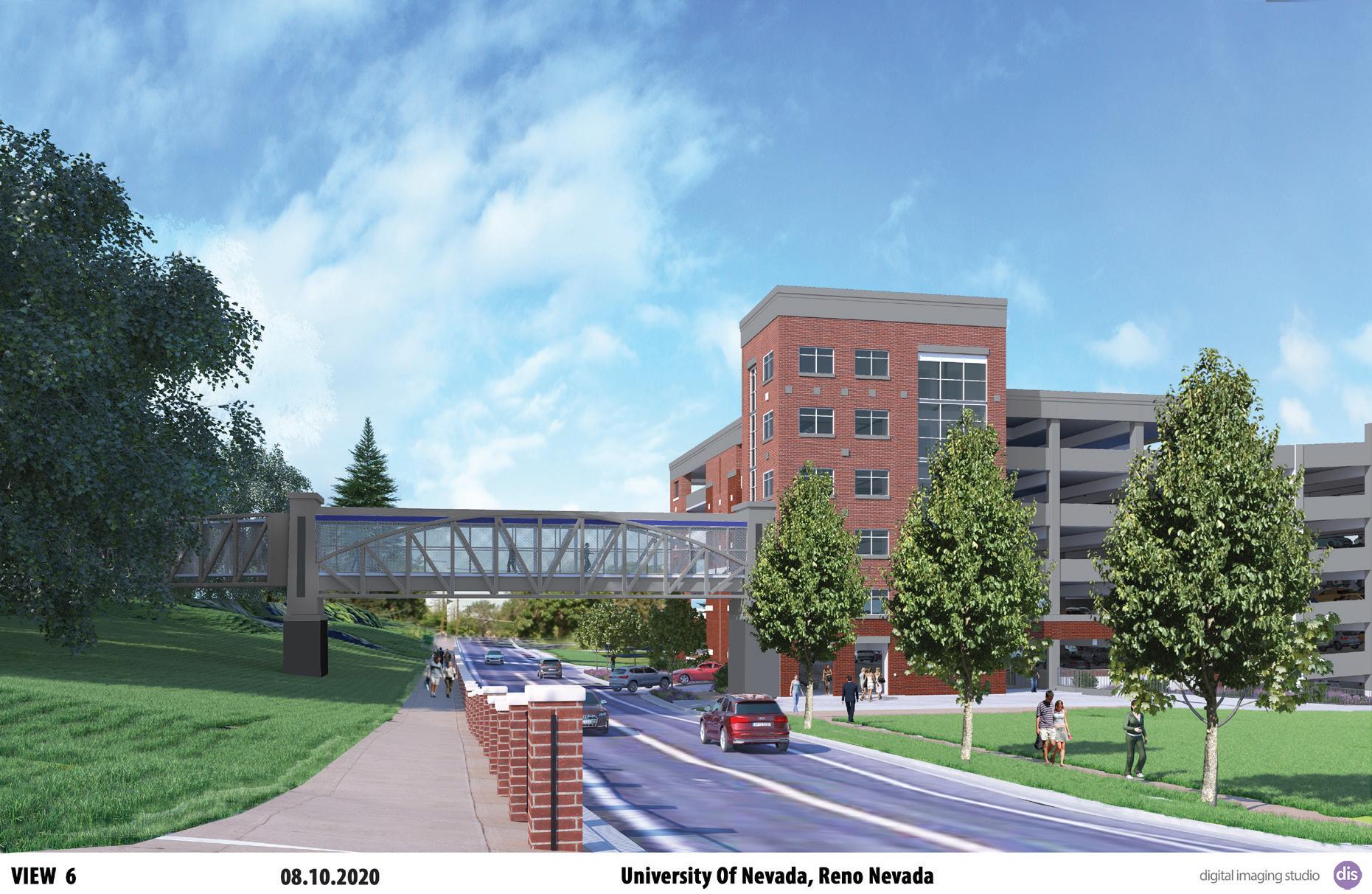
In the short-term, capital construction projects associated with the Gateway will have real economic benefit. Longer term, the Gateway concept will connect the heart of Downtown Reno with the heart of the University.

30 WOLF PACK RISING KEY INITIATIVES AND ENGAGEMENT
A championship culture
The University of Nevada, Reno has a rich history of athletic performance and achievement, with dozens of titles and championships across a wide range of men’s and women’s athletics. In many ways, Wolf Pack Athletics is the emotional heart of the University’s brand, a sentiment captured in the “One Community. One Pack.” theme that deeply connects our campus with the people of the Reno-Tahoe region.
Wolf Pack Athletics is home to 15 NCAA sports that compete in the Mountain West Conference. Here, women’s varsity sports include basketball, cross country, golf, soccer, softball, swim and dive, tennis, track and field, and volleyball. Men’s varsity sports include baseball, basketball, cross country, football, golf and tennis. Wolf Pack Athletics provides a championship experience with integrity on and off the field for student-athletes and the Wolf Pack nation. Wolf Pack Athletics aims to be the model collegiate athletics program in the Mountain West Conference as well as the nation through the integration of excellence in academics, athletics and community. Wolf Pack Athletics is home to the Fremont Cannon, college football’s largest and most expensive trophy.

Wolf Pack Athletics has won eight Mountain West Conference Championships, with the most recent, in April 2022, coming from Men’s Tennis, who won their first conference championship since 1982. In 2021, Men’s Baseball became Mountain West Conference Champions for their performance in the regular season. That same year, the University celebrated our two newest All-Americans, Dillan Shrum (Baseball – ABCA, D1BB 2nd) and Nicola Ader (Track and Field – NCAA Indoor 2nd Team Pentathlon).
Wolf Pack Athletics was honored with the 2021-22 Mountain West Student-Athlete Advisory Council Community Service Award. It is the fifth time in the past eight years that Nevada has earned the award, which is a friendly competition between Mountain West teams.
Through the Mountain West Student-Athlete Advisory Council, many of our student-athletes—across all teams—volunteered for community engagement activities. Through their hard work and initiative, they created a better environment for organizations they partnered with and enhanced community support for Wolf Pack Athletics teams throughout the Reno-Tahoe region. Our student-athletes completed 2,272 hours of community service amidst COVID-19 restrictions and served the Food Bank of Northern Nevada, Girls on the Run Sierras Fall Program and 5K, Renown Children’s Hospital, Boys and Girls Club of Northern Nevada, Reno Pride Parade and Event, Girl Scouts of Northern Nevada and more.
Wolf Pack Athletics aims to exceed our high expectations where we inspire and build character in our studentathletes, our program, our university and our state.

'23-'27 STRATEGIC PLAN • University of Nevada, Reno 31
Rising to the challenge
Wolf Pack Rising represents our University’s commitment to moving onward and upward in our continued efforts to better serve students, faculty and staff, the state of Nevada and beyond. With the collective vision of our University community, we have charted a course for our future - now the Pack must rise to the challenge. The same way the entire community played a role in the production of this plan, we all must also play a role in its execution.
To measure our success in achieving these goals, the University community will have access to a scorecard which will track the progress of actions, outcomes and key metrics. Our University leadership, including the President and Provost, among others, will also track progress of each University unit’s strategic plans and their alignment with and contribution to the University’s strategic plan execution. Throughout each academic year, the University community can
expect to receive updates through various media, including campus announcements, newsletters and the President’s State of the University address. Tracking and reporting progress regularly enables us to hold ourselves accountable as a University community in making progress for the future of our University.
This strategic action plan serves as a framework to enable us to advance our position as a leader in student success, faculty and staff achievement and connection with the communities we serve. We created a roadmap that builds on our strengths, meets our challenges and fully leverages opportunities for the future. Our University possesses the unparalleled energy, commitment and passion to now rise to the occasion and reach our fullest potential for years to come.

Go Pack!
32 WOLF PACK RISING
INSPIRING EXCELLENCE
Alma Mater
THE MACKAY SONG
Words by Jack H. Morse, written in 1924 Where the Truckee’s snowfed waters, Drop from mountain’s crest, And the meadows meet the sagebrush, By the sun caressed. Cradled by the silver mountains, ‘Neath the western blue, Stands our noble Alma Mater, Our Nevada U.

As the miner, on the desert, Prospects ev’ry place, So Nevada seeks the future
With an upturned face. Ev’rywhere she gathers knowledge, All that’s good and true, Gives she to her sons and daughters, Of Nevada U.
We will ever live to serve her, Live to give our best, Live to make our Alma Mater Pride of all the West. Let her praises wake the echoes, While we pledge anew, Hearts and minds and hands and voices To Nevada U.

“Our Strategic Plan is an ‘action’ plan — a recognition that in order to successfully enter the next 150 years as Nevada's original land-grant institution, there have to be achievable as well as ‘stretch’ objectives that strengthen our history of inspired excellence.”
— Brian Sandoval, President







































